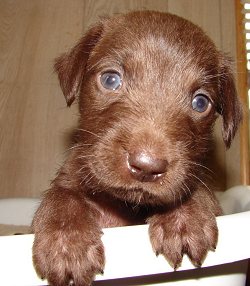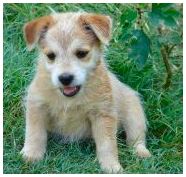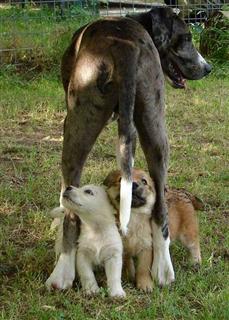|
A puppy is not physically able to control the muscle that allows him to "hold it" until he is about 12 weeks of age. Before this time, good housebreaking routines should be practiced to avoid having your puppy urinate and defecate all over your house.
Watch for signs of urination or defecation, such as turning in circles. Take your puppy out often. Using a crate or confining your puppy to a small part of the house that has easy clean up floors are some ways to ensure your puppy does not urinate all over your house. It is much harder to housebreak a puppy if he smells is urine in places you do not wish him to relief himself.
If space is an issue for having a crate consider all of the options. In addition to wire crates, there are now wood dog crates available on the market. A wood dog crate serves as a multi-functional piece. Not only can it be used for the dog crate, but it also serves as a piece of furniture for the dog owner.
Understanding your puppy or dog: Will I ever get there?
There are many different methods in which you can housebreak your pet. Whichever way you choose, it is important to understand your puppy. Dogs want to please; the trick is to make them understand what it is you want from them.
Dogs do not think the way humans do. When you are unhappy with your dog, it assumes that whatever it is doing at the exact moment you show disapproval - is the thing that is upsetting you.
For example:
If your puppy relieves himself on your floor and you show your disapproval five minutes after he has committed the act, the puppy will think that the mess on the floor is bad. He will not relate to the fact that it was the act of relieving himself on your floor that you disapprove of.
The dog will eliminate, see the mess and get worried; you are now going to be unhappy. This is the reason so many dogs will relieve themselves in inappropriate places and look really guilty about it, yet they continue to do it. Dogs want to please, right?
Some owners start to think that their dog is being sneaky when really it does not fully understand what it is doing wrong. It knows the mess upsets you but does not understand that it should stop making the mess.
To your dog, these two things:
are unrelated.
The trick is to catch your dog in the act and make him understand.
NEVER EVER hit your dog, there is simply no need for it; it will always do more harm than good. Dogs in their natural habitat do not listen to frustrated, angry or emotional pack leaders.
An assertive "No! You are not allowed to go in the house. No! No!" is all that is needed. Immediately take your dog outside to the appropriate place. |
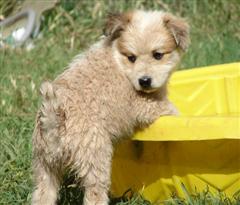 |
| Wait for your dog to go again and when and if he does, praise him.
Important: Always praise your dog after he eliminates in the appropriate place. |
Crate Training:
Before you crate train, please be aware: a dog that is left in a crate all day long, gets let out in the evening after work for a few hours and put back in the crate for the night can become neurotic, destructive, unhappy and noisy. If you work all day, it is recommend that you find someone who can take your dog out for a long walk in the afternoon.
If this is not possible only use the crate at night. If you must leave your dog all day long every day and you have nobody to let the dog out during the day, you should find a room without a rug, put down Pooch Pads Reusable Housebreaking Pads, food, water and toys. You should set up the room so that the bed and food are at one end and the pee pads at the other.
Spread the toys in the center of the room. Dogs are not fish. They need to find something to occupy their mind, so give your dog plenty of toys. It is said that dogs are den animals and like the crate, but even a den animal would go crazy if it was lock up all day long.
You must be willing to invest time and energy for just a few short weeks in housetraining. The effort you put in now will last for the rest of your pet's life.
The crate training method is as follows:
Buy a crate and for the first 3 to 4 weeks keep your puppy in it when you are not with him. Make sure the crate is not too big. It should be large enough for the puppy's bed, but no larger.
Dogs do not want to soil their bed and the use of a crate teaches them to control their urge to eliminate. You must maintain an eagle eye at all times.
As soon as you see him pacing, sniffing around, and turning in circles, immediately take him outside. He is telling you "I am going to go pee pee somewhere, and this carpet looks like as good a place as any." NO, you do not have time to put on your shoes, just go.
Be patient and do not rush the little guy. He may have to go several times in one "pit stop." Give him about 10 minutes before taking him back inside. Do not play with him while you are on this mission. Let him know this is a business trip.
Make sure you take him out after every meal and play session BEFORE you put him back in his crate.
Be consistent and establish a schedule. Pay attention to your puppy's behavior so you can develop a schedule that works for you and the pup.
When does your puppy naturally defecate? In the morning? 10 minutes after eating? Around bedtime? You may have to make some compromises. |
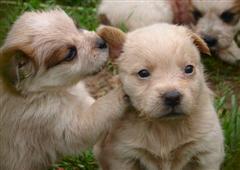 |
Be fair to your puppy. He cannot be expected to stay alone in his crate for endless hours and not relieve himself. During your work days, you will need to have someone go to your home at least once (lunch time is good) to let the puppy out.
Take him for a long walk. Your dog is not a fish and he needs something to occupy his mind. |
Make sure everyone who is involved in the housebreaking process is using the same spot in the yard and the same word. Everyone should agree on the place they will take the puppy. The odor from the previous visits will cause the puppy to want to go in that spot.
Use a simple word like "outside" when taking your puppy to the chosen spot. Use this word consistently and later this word will help build communication between the family and the dog. When you notice him going toward the door and you say "outside" he can say "Yup, that’s where I need to go," or, "Forget it. I am getting back up on the couch for some shut eye."
Until your puppy is about 5 months old you will need to take him out frequently and keep that eagle eye on him. But before you know it, you are going to be able to trust and communicate with your new pet. And he will learn that when he pleases you by going out to do his business, he gets more freedom in the house.
Paper Training:
If your puppy is a breed that stays small and it is going to be an indoor pet, you may want to try paper training. Place layered newspaper in the corner away from the feeding and water dishes. After meals take the puppy to the newspaper. Each time the puppy eliminates, change the top layer of newspaper and leave the bottom layer. Puppies like to go where they smell urine and feces and will start to prefer the newspaper over any other spot.
Important:
Remain consistent. Do not allow your puppy to do something one day and not the next. This will confuse him. Never leave an untrained puppy unattended in the house. Make your dog understand what is expected of him. Dogs want to please. Always praise your dog for good behavior. No form of physical punishment is as effective as praise and encouragement.
References:
Written by Sharon Maguire and Dawn Littlefield
Dogbreedinfo.com
|
